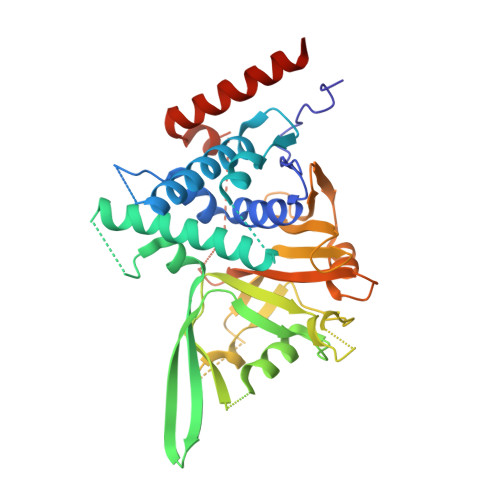Structure-based discovery of potent USP28 inhibitors derived from Vismodegib.
Zhou, D., Xu, Z., Huang, Y., Wang, H., Zhu, X., Zhang, W., Song, W., Gao, T., Liu, T., Wang, M., Shi, L., Zhang, N., Xiong, B.(2023) Eur J Med Chem 254: 115369-115369
- PubMed: 37075624
- DOI: https://doi.org/10.1016/j.ejmech.2023.115369
- Primary Citation of Related Structures:
8HJE - PubMed Abstract:
Ubiquitin-specific proteases (USPs) 28 is overexpressed in multiple types of cancers. The development of potent USP28 inhibitors is still in primitive stage. We previously reported our discovery of Vismodegib as a USP28 inhibitor by screening a commercially available drug library. Herein, we report our efforts to solve the cocrystal structure of Vismodegib bound to USP28 for the first time and subsequent structure-based optimization leading to a series of Vismodegib derivatives as potent USP28 inhibitors. Based on the cocrystal structure, elaborative SARs exploration was carried out to afford much more potent USP28 inhibitors than Vismodegib. The representative compounds 9l, 9o and 9p bearing high potency on USP28 showed high selectivity over USP2, USP7, USP8, USP9x, UCHL3 and UCHL5. The detailed cellular assay suggested that compounds 9l, 9o and 9p could cause cytotoxicity in both human colorectal cancer and lung squamous carcinoma cells and significantly enhance the sensitivity of colorectal cancer cells to Regorafenib. Further immunoblotting analysis indicated that compounds 9l, 9o and 9p could dose-dependently down-regulate the cellular level of c-Myc through ubiquitin-proteasome system and anti-cancer effects could mainly be attributed to their inhibition on USP28 but not involving the Hedgehog-Smoothened pathway. Thus, our work provided a series of novel and potent USP28 inhibitors derived from Vismodegib and may contribute to the development of USP28 inhibitors.
- Anhui University of Chinese Medicine, 350 Longzihu Road, Xinzhan District, Hefei, Anhui, 230012, PR China; Yangtze Delta Drug Advnced Research Institute, 100 Dongtinghu Road, Nantong, 226133, PR China.
Organizational Affiliation:

















